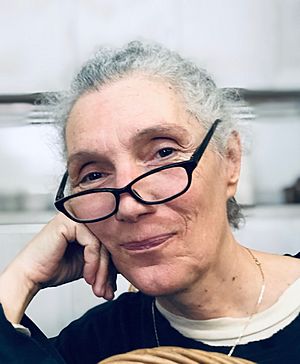Jana Sterbak facts for kids
Jana Sterbak is a famous Czech-Canadian artist. She is known for creating art that makes people think. She uses many different types of art, including sculpture, photography, and video. Sterbak is famous for using unusual materials, like meat, chocolate, and bread, to create her artworks.
Contents
Early Life and Education
Jana Sterbak was born in Prague, which was then in a country called Czechoslovakia. When she was a teenager, her family moved to Canada. She later became a Canadian citizen.
Sterbak went to Concordia University in Montreal, where she earned a Bachelor of Fine Arts degree. She studied film and painting. She also studied art history at other universities but decided to focus completely on making her own art.
A Career in Art
Sterbak's art career took off in the 1980s. By 1991, when she was only 36, the National Gallery of Canada held a major exhibition of her work, called a retrospective. This show then traveled to museums in the United States.
In the 1990s, Sterbak moved to Paris, France, to teach at a famous art school. Her work became well-known in Europe. She showed her art at big international events like the Venice Biennale. She also had her own shows at famous museums, including the Louisiana Museum of Modern Art in Denmark and the Museum of Modern Art (MoMA) in New York.
In 2003, she represented Canada at the Venice Biennale again with a video installation called From Here to There. Another one of her famous videos is Waiting for High Water, which she filmed in Venice during a flood.
What Makes Her Art Special?
Jana Sterbak's art is both poetic and political. She uses her life experiences to explore big ideas about freedom, human conflicts, and how people connect with each other. Her work is known for being surprising and making viewers see everyday objects in a new way.
Using Unusual Materials
One of the most notable things about Sterbak's art is her choice of materials. She often creates familiar objects, like clothes or furniture, but makes them out of things you would not expect.
- Temporary Materials: Some of her art is designed to change or disappear over time. For one piece, she built chairs out of ice that slowly melted.
- Food as Art: She has used food in many sculptures. In 1997, she made a bed out of bread and a stool out of cake. In 1992, she created a human skeleton out of solid chocolate called Catacombs.
- Challenging Materials: She also uses materials like metal and wire. One piece, called I Want You To Feel the Way I Do… (The Dress), is a dress made from electrified wire.
By using these materials, Sterbak makes people think about life, comfort, and what we value.
The Famous "Flesh Dress"
Sterbak's most famous artwork is called Vanitas: Flesh Dress for an Albino Anorexic (1987). It is a dress made by sewing together pieces of raw flank steak.
The dress is a powerful statement. It comments on how society can treat women like "pieces of meat." It also makes people think about fashion and the pressure to have a certain body type. The dress slowly dries out and changes as it is displayed, which is a metaphor for aging and how all living things decay. This piece has been discussed and copied by many, but it remains one of her most important works.
Awards
Jana Sterbak has won many awards for her art.
- 1991: Guggenheim Fellowship, John Simon Guggenheim Memorial Foundation, United States
- 1993: Prix Antoine Guichard, Foundation Casino, Musée de Saint-Étienne, France
- 1993: Victor Martyn Lynch-Staunton Award from the Canada Council
- 1996: Prix Ozias Leduc, Fondation Émile-Nelligan, Montreal
- 2012: Governor General's Awards in Visual and Media Arts, Canada
- 2017: Prix Paul-Émile-Borduas, Québec
See also
 In Spanish: Jana Sterbak para niños
In Spanish: Jana Sterbak para niños


